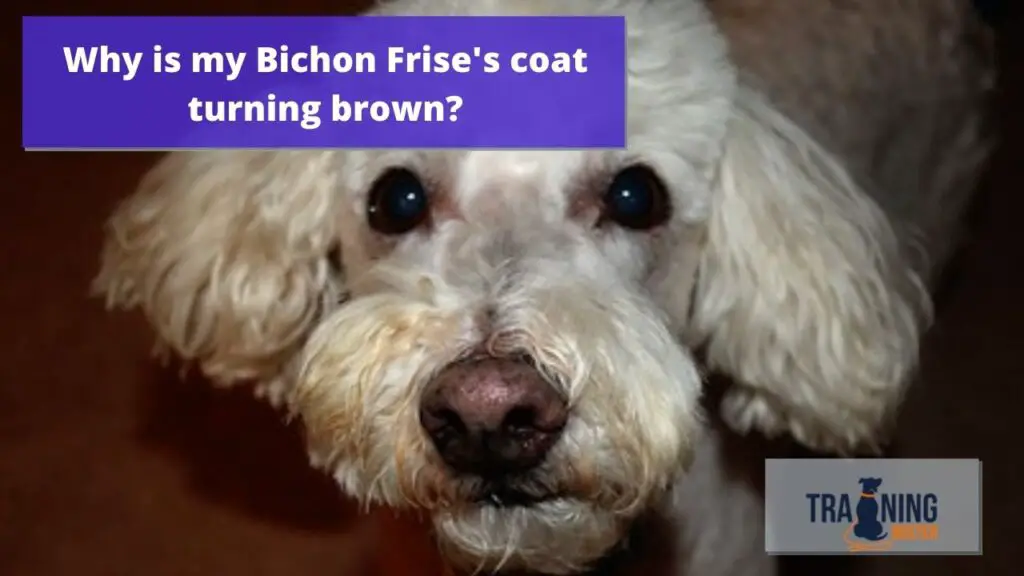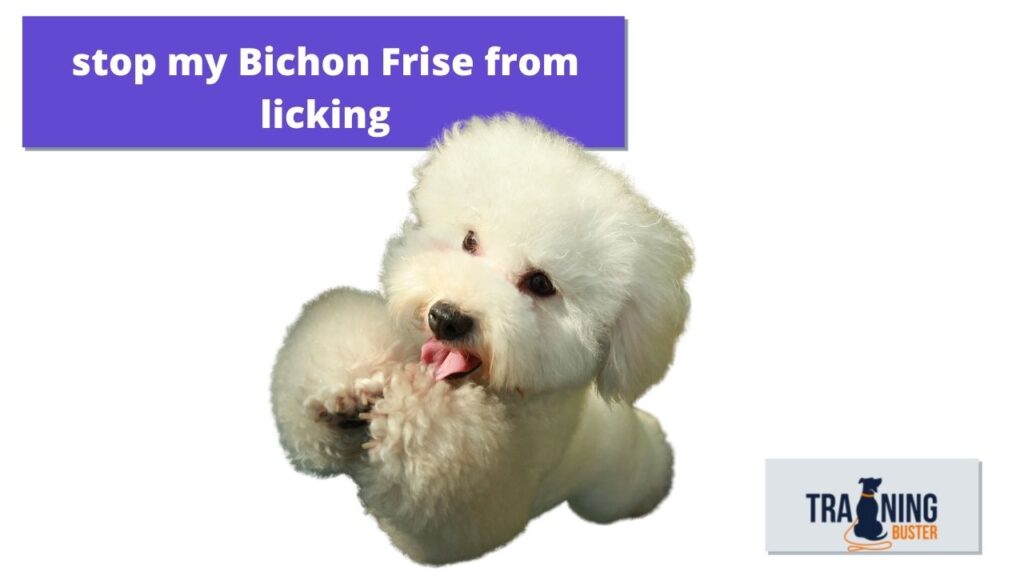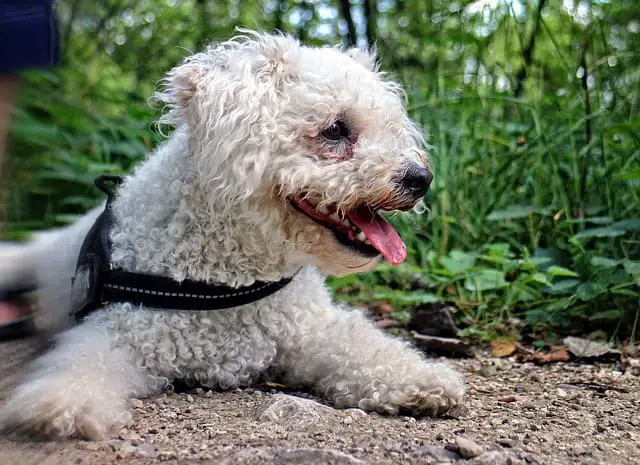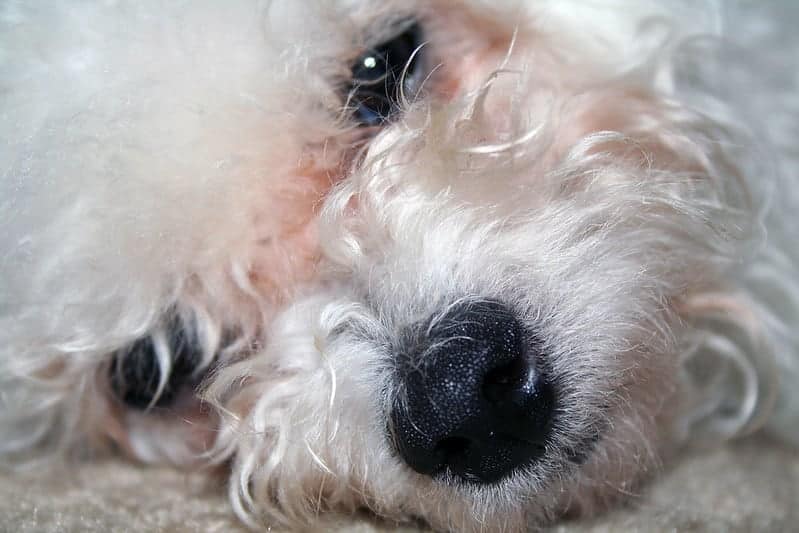The Bichon Frise is a truly fluffy dog with a stunning white coat. The Bichon Frise’s downy curls present unlimited styling opportunities for many owners. But unfortunately, this soft fur is prone to getting unintentionally dyed by its surroundings.
So, why is my Bichon Frise’s coat turning pink or brown? How can I tell if my Bichon Frise’s coat is healthy? And what can I do about staining? In this article, we explore the reasons why your Bichon’s coat would be any color other than white, and what you should do about this:

Why did my Bichon Frise’s fur turn pink or Brown?
As we touched upon earlier, there are many potential reasons why your Bichon Frise’s hair might turn pink or brown. One common reason for pink fur staining in a Bichon Frise is yeast dermatitis.
This is a condition where a fungus overgrows on your Bichon Frise’s skin. However, yeast isn’t the thing that causes the staining. Instead, as the yeast begins to cause discomfort, your Bichon Frise licks at it, resulting in pink or rusty staining from the porphyrin in their saliva.
Your Bichon Frise may also lick at their skin and fur due to other sources of inflammation, infection, or discomfort. This could be due to food or topical allergies, a parasitic infestation, bug bites, or anything else. Your Bichon Frise could even simply be grooming themselves excessively due to boredom.
Whatever the problem turns out to be, getting to the bottom of it and treating it promptly with the correct medication will stop the staining from getting worse or causing permanent skin or fur problems.
Porphyrin is also found in tears, meaning it is also the benign culprit for the tear stains many a Bichon Frise owner is familiar with. Pink or brown fur around the eyes is normal for Bichons.
How do you get stains out of Bichon Frise hair?
Depending on the cause, getting brown or pink staining out of your Bichon Frise’s hair can be as quick and simple as giving them a bath with household ingredients. Talk to your Bichon Frise’s vet before you begin any intensive fur whitening treatment, especially if your Bichon Frise is currently already using a medicated topical treatment.
A standard whitening shampoo for dogs is a good option. Lather the shampoo all over your Bichon Frise’s body as you normally would, making a special effort to cover the pink or brown areas. Then, when you’ve washed the suds away, dab a little white vinegar or hydrogen peroxide on the particularly stained areas. Avoid sensitive areas like your Bichon Frise’s eyes, anus, and genitalia, no matter how stained these areas are.
After leaving your chosen solution on your Bichon Frise’s fur for around 15 minutes, rinse it away. Dry your Bichon Frise’s hair with extra care – a damp environment is a paradise for fungus. Carry out this treatment again for as many days as it takes to remove your Bichon Frise’s staining. If you’re still having difficulty removing the stains after a few days, you may like to trim your Bichon Frise’s hair with some grooming scissors or take them to your groomer.
Products that removes stains out of Bichon Frise hair?
- Petpost Tear Stain Wipes for Dogs, 100 count
- Petpost Whitening Dog Shampoo, 16-oz bottle
- John Paul Pet Sensitive Skin Formula Oatmeal Dog & Cat Shampoo
How can I stop my Bichon Frise from licking?

If your Bichon Frise licks their skin and fur excessively, whether due to discomfort or boredom, what can you do about this? Excessive licking is a common problem for the Bichon Frise, after all.
If you find that your Bichon Frise grooms themselves and others excessively for no reason, they may simply be bored. One solution is to give them something else to lick, like a lick mat toy, covered with unsweetened yogurt, cream cheese, peanut butter, or wet food. Freezing the ingredient will make it take longer to lick off, keeping your Bichon Frise occupied for longer. You can even just use plain ice or a spare ice cube tray.
You could also give your Bichon Frise their food in a puzzle feeder or food-dispensing toy like a Kong. Snuffle mats are another time-consuming option. You can also simply hide your Bichon Frise’s kibble around the house, leaving it for them to sniff out. Some old toilet roll tubes, plastic cups, and other used food packaging make good options. Just don’t use bags. Get creative!
If your Bichon Frise is still licking out of boredom, you may like to try physically exhausting them before they settle down to rest. You could use their kibble as rewards and ask for loads of physical obedience commands like sit, lie down, and rollover. You could also try taking your Bichon Frise for longer walks or playing more fetch and tug-of-war.
How can I prevent yeast in my Bichon Frise?
The best way to prevent yeast and keep your Bichon Frise as healthy as possible is to keep their body as dry as you can at all times. This means prompt and thorough towel drying after a swim, bath, or walk in the rain or on damp ground. This may also mean keeping a flannel or face cloth handy for a quick paw wipe after doing their business in a dewy yard in the morning.
If your Bichon Frise spends a lot of time in damp conditions, you may even like to invest in a light raincoat or doggy boots. This is a surefire way to keep the damp out of their toes and fur. Another good idea is to simply keep their fur in a short, manageable style. Buzzing your Bichon Frise with the clippers at home will prevent their fur from getting long enough for infection to set in.
Finding the right shampoo for your pooch’s skin can go a long way in keeping your Bichon Frise healthy, too. A sensitive skin shampoo like this Oatmeal Dog and Cat Shampoo from John Paul Pet will keep your Bichon yeast-free when used often, while this Whitening Shampoo from Petpost will help if your Bichon Frise does develop minor staining. Between baths, these Tear Stain Wipes from Petpost will keep your fluffball’s eyes gunk-free.


